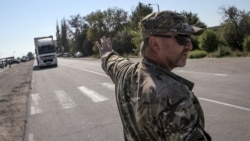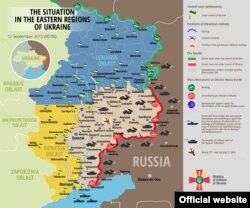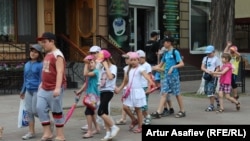Here's a map of the latest situation in the restive Donbas region, issued by the Ukrainian Ministry of Defense (click image to enlarge):
It seems schoolchildren will be learning a little bit more than the "three Rs" this term (based on reporting by RFE/RL's Russian Service):
For millions of children returning to school аcross Ukraine this year, there's been the usual starched shirts and itchy dresses, poufy hair ribbons and neckties, new backpacks and pencils, and homework in math, science, and reading.
In the southern Ukrainian city of Mariupol, there's a new addition to the curriculum this year: landmines and unexploded bombs, and what to do with them.
Education authorities in Mariupol have rolled out materials throughout the city's 68 schools to teach children about the dangers of hidden landmines or bombs that have not been detonated.
More than 109 children have been injured and 42 killed by landmines and unexploded ordnance in Ukraine since the conflict between Kyiv’s forces and pro-Russian separatists erupted in April 2014, according to United Nations figures.
In Mariupol itself, a 4-year-old child was killed and three children were injured on August 24 when an unknown object they were playing with exploded, according to UNICEF.
The materials distributed to schools in Mariupol were reportedly designed in conjunction with the Organization for Security and Cooperation in Europe (OSCE). Officials with the Vienna-based organization could not be reached for comment.
"Children's psychology is very unstable, though of course, much depends on how you perceive these events -- war, fighting," Olga Samoilova, director of a Mariupol school called Lingua-21st Century, told RFE/RL.
"Just imagine how many children have been left without fathers, without older brothers, without grandparents. At my school, too, there are two such children -- one grandfather, his father, and the other died in the [fighting]" she said.
"And then there are children who have become disabled, such as [one girl] who was left without a leg after the eastern districts were shelled," she said.
With nearly 500,000 people located on the shores of the Sea of Azov, Mariupol is a strategic hub that sits astride the main highway running from the border with Russia to the east and westward to the Ukrainian peninsula of Crimea, which Russia seized and annexed in March 2014.
The conflict has brought fierce fighting and artillery shelling to the edge of the city, which the separatists have previously vowed to capture.
There are no definitive figures on the numbers of landmines or unexploded ordnance that have been scattered throughout Ukraine, which is a signatory to the 1997 treaty that banned the use of antipersonnel mines.
Human rights groups have also accused Ukraine of using cluster munitions, which are weapons that explode and then send smaller bomblets scattering across a battlefield. Often the bomblets are small enough that they resemble children’s toys, heightening the danger for children.
The United States says Russia has sent troops and weapons into eastern Ukraine to support the separatists in the conflict, which has killed more than 7,900 people since April 2014. Moscow denies the accusation despite significant evidence of such involvement.
Some might find the tone of the commentary a little bit gung-ho, but this is a very slick and useful Vox video explainer on Ukraine's seemingly tortuous reform process:






